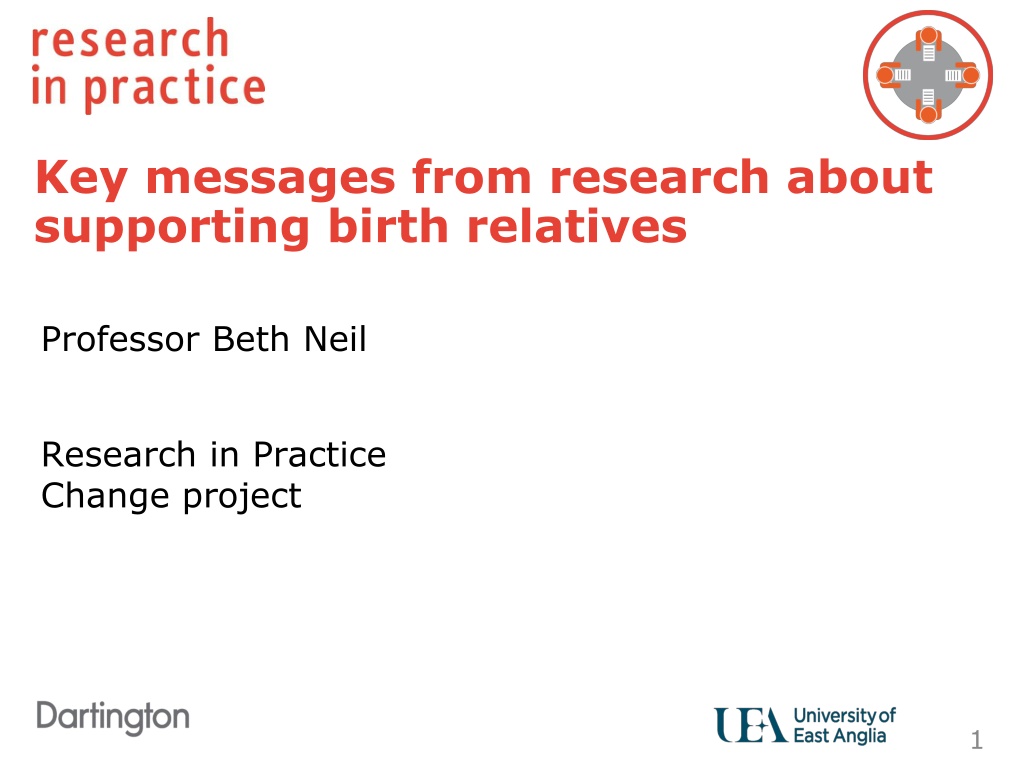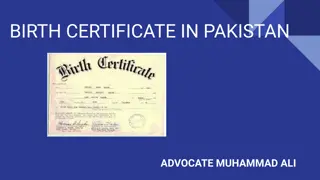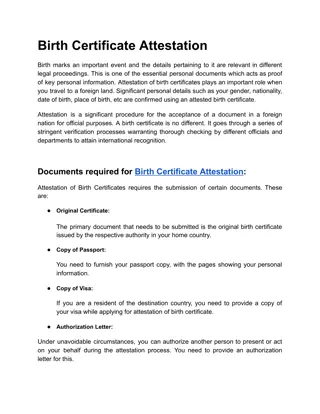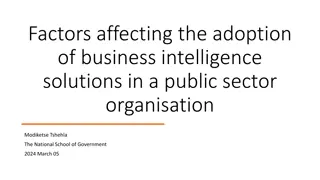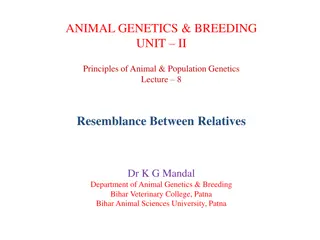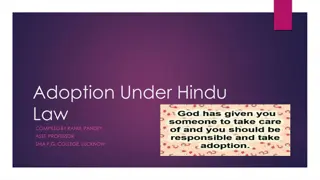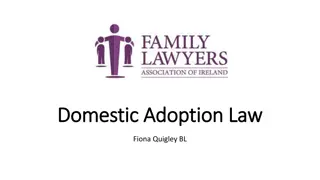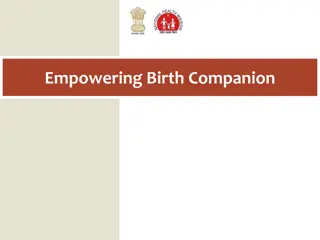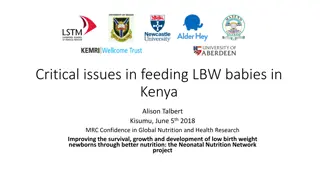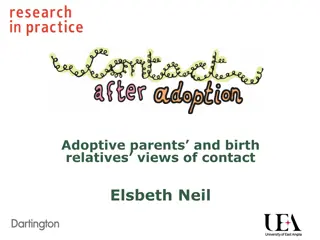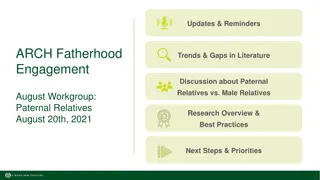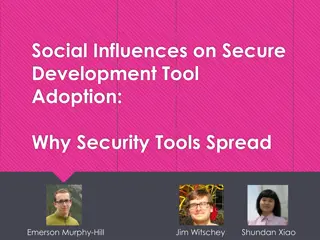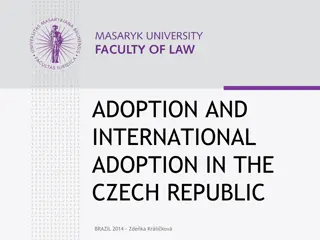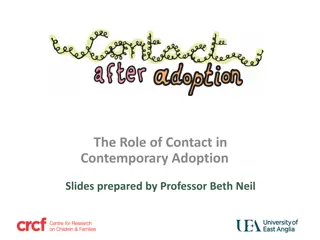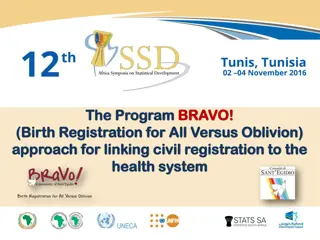Supporting Birth Relatives in Adoption: Key Research Findings
Birth parents and families involved in adoption have specific needs and emotions that should be recognized and supported throughout the adoption process. Research highlights the importance of providing lifelong services, fair treatment, access to support workers independent of social workers, and opportunities to contribute to their child's heritage. Birth relatives often experience complex feelings such as loss, anger, bewilderment, and guilt. Challenges faced by birth families include unsupportive relationships, substance misuse, mental health issues, and adversity precipitated by adoption. Efforts to provide support services vary in uptake, with mothers being referred more often and fathers less likely to access services. Understanding the needs and experiences of birth families is crucial in providing effective support services.
Download Presentation

Please find below an Image/Link to download the presentation.
The content on the website is provided AS IS for your information and personal use only. It may not be sold, licensed, or shared on other websites without obtaining consent from the author. Download presentation by click this link. If you encounter any issues during the download, it is possible that the publisher has removed the file from their server.
E N D
Presentation Transcript
Key messages from research about supporting birth relatives Professor Beth Neil Research in Practice Change project 1
Adoption and Children Act 2002: National minimum standards Birth parents and birth families are entitled to services that recognise the lifelong implications of adoption. They will be treated fairly, openly and with respect throughout the adoption process. They must have access to a range of support services before and after adoption Birth parents are entitled to a support worker independent of the child's social worker Birth families should be enabled to contribute to the maintenance of their child s heritage
Birth parent research at UEA The Contact after Adoption study Included interviews with 72 birth relatives involved in post adoption contact, some up to 18 years post placement (Neil 2007; Young & Neil 2004, Neil et al, 2015) The Helping Birth Families Project 77 birth relatives. (Neil et al, 2010; Neil & Cossar 2009; Neil 2013)
Birth relatives feelings loss anger bewilderment/confusion guilt anxiety powerlessness shame and stigma 4
Birth families needs Unsupportive/violent relationships Substance misuse, mental health problems, learning difficulties, poverty Life long adversity Crises precipitated by adoption Mutual disengagement between parents and professionals Blame and shame An adversarial process Lack of closure, lack of information about child Unclear role Managing stigma Disenfranchised, ambiguous loss
A survey of take up of support services N= 495 (Neil et al 2010) Who was referred? Mothers (67%), fathers (20%), others (13%) 56% had used a service: fathers significantly less likely to take up service Take up best when referral by self or others vs children's services (80% vs 57%) Take up varied dramatically by agency (19-74%) 6
Helping birth families (Neil et al, 2010) Two thirds of birth relatives interviewed had used support services 83% of these received emotional support 54% received advice and information 60% received help with contact 48% received advocacy and liaison 33% received group or peer support
Evaluations of support services 73% of birth relatives were primarily positive about support services, 21% were mixed/neutral, 6% were primarily negative Factors associated with satisfaction : (1) Relationship-based support My support worker was the first person I have ever spoken to about losing the children who listened, who didn t judge, who didn t assume that because I had lost my children I was a bad person.
(2) Confidentiality and independence If I felt really down and anxious I wouldn t have dared tell social services because they d say I m being unpredictable, I can t control my emotions and I d be scared they wouldn t let me see my kids. Where if I said that to this support worker she probably thinks, like me, like most people, that it s normal to feel like that if your kids are being taken away
(3) A flexible and proactive approach Contact outside of scheduled appointments Flexibility about how much and what type of support could be accessed Being able to drop in and out of services Flexibility about where support was provided Workers making the running and being proactive in keeping in touch
Measuring outcomes Coping with adoption Acceptance of dual connection Feelings about the outcomes of adoption for the child Coping with the impact of adoption on self Brief Symptom Inventory (Derogatis) 53 item self report questionnaire
Does using services help birth relatives? Average cost over 1 year = 511 (0- 4563) The greater the costs and services (reported by agency) the greater the improvement in mental health scores over the follow up period Birth relatives who had used services had significantly higher coping with adoption scores than those who had not used services
The importance of a range of services Use of a greater range of services was associated with higher levels of coping The number of different types of services received used predicted satisfaction with service provision
The helping birth families study: contact issues Contact with child frequently lost before adoption Constructive participation in contact planning, life story work, meeting adopters etc affected by poor relationship with SSD and poor functioning of parent Many parents reported contact gap between child s placement with adopters and first contact of 18 months or so; no info in this period Help with contact needed and valued and often a foot in the door 14
Three patterns of adjustment/acceptance (Neil, 2007) Positive acceptance Resignation Anger and resistance
Positive Acceptance Acknowledging that child is now also part of another family, and has other parents Positive feelings about the adoptive parents Feeling pleased about how things had worked out for the child Positive participation in contact - staying in touch and supporting the child and adoptive parents
Achieving positive acceptance: lessons about supporting birth relatives Good post adoption contact in itself promotes birth relatives adjustment Support for birth relatives is an essential part of supporting contact Offering help with contact can be a way in to supporting birth relatives more generally
Resignation The reality of the loss is accepted, but The person feels they have no choice but to accept this: there is nothing they can do Feelings of being unable to control events Feelings of shame, worthlessness and guilt Often anxious about child Often unable to initiate or respond to contact Main feelings about adoption are sadness and depression
What do these feelings suggest about support? Passivity, resignation and low self worth may be reasons why people don t seek out services or take up offers of services A sense of loss is the most prominent feeling, so emotional support may be valued Non judgemental support helps with low self esteem
Anger and resistance The reality of the loss of the child is (usually) understood, but not accepted emotionally Anger at others; adopters not real parents Anger could stop people keeping up contact: They do that in prison and I m not a prisoner. Or it could motivate people to keep in contact: I don't want her growing up thinking that it's me that's done it when it's them that's done it.
Support issues For some, anger, hostility and lack of trust will be significant barriers to accepting support Fair and open treatment before and during adoption may reduce anger after adoption Independence and confidentiality is vital Offers to help may need to be repeated at different points in time, or by different people Advocacy, information and advice, practical support or help with contact may be more acceptable than counselling Intense, unrealistic perceptions of adoption that don t change may be contraindication for contact
Acceptance of adoption: changes over time Most changes in acceptance happened early on. These categories then were generally stable. Changes in teenage years were between acceptance and resignation category and were linked to changes in contact Birth relatives encountered new challenges in child s teenage years: child s increase in problems; child s changing views of contact; worries about what happens when child aged 18; contact suddenly ceasing 22
Conclusions about birth relative support Different needs of different people at different stages: take account of birth relative type, level of acceptance, time since adoption, special needs etc Getting people to start and continue using services is challenging: Flexible casework services with a proactive outreach approach are indicated
Further reading The UEA Helping birth families study: http://www.adoptionresearchinitiative.org.uk/study5.html Neil, E., Beek, M. & Ward, E. (2015) Contact after adoption: a longitudinal study of post adoption contact arrangements. London: CoramBAAF. Neil, E. (2013) The mental distress of the birth relatives of adopted children: disease or unease ? Findings from a UK study. Health and Social Care in the Community, 21(2), 191- 199. Cossar, J and Neil, E. (2013) Making sense of siblings: connections and severances in post-adoption contact. Child and Family Social Work, 18, 67-76.
Neil, E., Cossar, J., Lorgelly, P. and Young, J. (2010) Helping Birth families: services costs and outcomes. London: BAAF. Cossar, J. and Neil, E. (2010) Supporting the birth relatives of adopted children: how accessible are services? British Journal of Social Work 40/5: 1368- 1386. Neil, E. (2009) The corresponding experiences of adoptive parents and birth relatives in open adoptions . In Wrobel, G. and Neil, E. (Eds.) International advances in adoption research for practice. Chichester: Wiley/Blackwell. 25
Neil, E. (2007) Coming to Terms with the Loss of a Child: The Feelings of Birth Parents and Grandparents about Adoption and Post-Adoption Contact , Adoption Quarterly, 10 (1), pp. 1-23. Young, J. & Neil, E. (2004) The Contact after Adoption study: The perspective of birth relatives after non-voluntary adoption. In E. Neil & D. Howe (eds.), Contact in Adoption and Permanent Foster Care: Research, Theory and Practice. London: BAAF. Neil, E. (2003) Accepting the reality of adoption: Birth relatives' experiences of face-to-face contact. Adoption & Fostering, 27(2), 32-43. 26
